#Inverted Confrontation
Text

H̷̨̜̠̪͍̙̽̎̈́̆̎̆̓̏͜ę̵͕̙̦͚̰̼̲̫̉́̀̑̚̕ļ̶̧̢̧͈͓̞͈̜̆̋͆͌̚l̸̡̧̛̝͙̻͖̹͉͓̝̇̎̽͋̂̈́̅̏́͋̉ỏ̴̡̹̪̗̈́̿͋̾̊͛́͆̓̂̕͝
Everyone is free to interact!
@tmntstorycomp
@daboyau
Reference under read more!

#inverted confrontation#rise of the teenage mutant ninja turtles#rottmnt#tmntstorycomp propaganda#tmntstorycomp
83 notes
·
View notes
Text

@boots-with-the-fur-club and I were talking about the dynamic between her Inverted Confrontation Hyde (Donnie) and my Leave AU Four (Mikey) and I couldn’t get this image out of my head so I drew it
#rottmnt#rise of the teenage mutant ninja turtles#I tried my best#rottmnt au#rise of tmnt#leave/remain au#inverted confrontation au#Leave au extras#Leave au art
18 notes
·
View notes
Note
Question: where are you and everyone else watching the new Sonic Prime episodes?
The first episode is on youtube!
youtube
and the rest come out on netflix but I'm sure there will be other places to watch it!
#I freaked out typing this bc I'm on desktop for once in my life and I forgot about the firefox extension I have that inverts colours#and when I added the link I got confronted with fucking black eyed ghost sonic#amalgamorph#ask#egg.txt
15 notes
·
View notes
Text
every now and then I want to thank the creators of cobra kai for simply coming up with the entire concept. I don’t care how unhinged and unrealistic every season is. I don’t care how cringey the dialogue gets. I want to shake hands with whomever came up with the idea to start a tv show focusing on johnny lawrence, washed-up runner-up in the all-valley tournament whose life has gone complete downhill since losing the karate tournament to daniel larusso, the scrappy newcomer from new jersey who not only stole johnny’s title but also his gf. who’s the creator I want to respectfully kiss you directly on the mouth.
#this is the only way reboots should be done btw#no offense to jaden smith but that was not the way to reboot karate kid#this is how you reboot a show#purposefully inverting the themes of the original show - scrappy newcomer gets picked up by cobra kai instead of Miyagi??#grown men never outgrow their karate phase until the confront their trauma???#I’m eating this with the largest spoon I can find and I am not a large utensil user so you know that’s big#cobra kai
14 notes
·
View notes
Text
Symbiosis isn't just mutualism. Parasitism is symbiosis. It's uncomfortable to confront parasitic relationships if you want to see your human ideas of good and bad reflected in Nature.
But gazing into something huge and utterly Other, being uncomfortable means you're engaging your mind with it. "Uncomfortable" is actually a whole spectrum of emotions that become a vivid and satisfying rainbow.
There was a post a while back with some artwork of Dendrogaster, a crustacean that parasitizes starfish, and its body is like this branching fractal of fleshy lobes made to fit inside the body of the starfish mirroring its structure, and I was absolutely horrified to look at this, and this horror was the same emotion as a strangely visceral wave of sympathy for this parasite.
Creative works about parasites often invoke the horror of bodily invasion, which is visceral and strong for me, but this artwork inverted that horror, instead showing the horror of being made so perfectly for fitting within someone else that you lose everything you are and become unrecognizable.
I also think of the post about the cowbird chick. It's awful that the bird pushes its siblings out of the nest as it grows, and the mama feeds it because she instinctively must feed her chick, but the cowbird is just a baby. Was it wrong for him to hatch, to be alive, to be hungry, to be a baby and to need love?
Symbiosis is intensely beautiful, and sometimes it's beautiful because it's grotesque and terrible. Of course, the symbiosis between two organisms isn't an allegory for a relationship, it just is a relationship, but looking at the way organisms become entwined feels like you're seeing things that, if words described them, would also be human experiences.
Being invaded by a parasite is a horror of powerlessness and loss of autonomy, but being a parasite is also defined by powerlessness. In many cases, the parasite will die without the host, but the host can live without the parasite. I wonder why it is expected to sympathize with one and not the other.
Your immune system fights against internal parasites like a tapeworm...Imagine being a tapeworm. The body of your host is your universe. Do you find your world to be kind? Benevolent? Does your god love you?
Sometimes people call disabled people "parasites." When I think about my future sometimes I'm uncertain and afraid.
But when a rare non-photosynthetic orchid blooms in the forest, this is not the forest's weakness and failure, but its crowning glory.
3K notes
·
View notes
Text
Twist for your story
Ever wondered why a well-crafted twist is crucial in a story? It's like the element of surprise that keeps you engaged, challenges your expectations, and ultimately makes the narrative memorable. A great twist is the heart of intrigue in storytelling. Here are some you can use!
The Sentient Object:
Twist: An ordinary object, like a book, a mirror, or a piece of jewelry, is revealed to be sentient and possesses its own consciousness. It becomes a key player in the story, guiding or manipulating the characters.
The Collective Memory:
Twist: A group of characters, seemingly unrelated, share a mysterious collective memory or dream that connects them in unexpected ways. They must work together to decipher the meaning behind these shared experiences.
The Language of Magic:
Twist: Magic in your world is governed by a unique language or code. As the story unfolds, characters discover that the language itself is sentient and can influence events and outcomes.
The Eldritch Revelation:
Twist: Characters stumble upon ancient texts or artifacts that contain forbidden knowledge about cosmic horrors or eldritch beings. The revelation of this knowledge threatens their sanity and forces them to confront incomprehensible entities.
The Mythical Betrayal:
Twist: A character believed to be a mythical hero or savior turns out to be the story's true villain, deceiving everyone around them. The actual hero must rise from obscurity to confront this unexpected antagonist.
The Reverse Time Travel:
Twist: Instead of traveling to the past or future, characters unwittingly bring historical or future figures into their present. They must adapt to the challenges and paradoxes this brings, all while trying to return these displaced individuals.
The Living Ecosystem:
Twist: The entire world or ecosystem of the story is revealed to be a living, interconnected entity, and the characters' actions have profound consequences on its well-being. They must make choices that protect or harm this sentient world.
The Forgotten Prophecy:
Twist: Characters initially believe in a well-known prophecy, only to discover that the true prophecy has been hidden or forgotten, and its revelation drastically changes the course of their journey.
The Inverted Morality:
Twist: A society where good is evil and evil is good is introduced, challenging characters' beliefs and forcing them to question their own moral compasses.
The Quantum Reality Shift:
Twist: The story shifts between multiple parallel realities or dimensions, and characters must navigate the complexities of these shifting worlds to achieve their goals.
The Manipulative Reader:
Twist: It is revealed that a character within the story has the ability to influence the actions and decisions of the other characters, essentially "writing" the story's plot from within.
The Protagonist Swap:
Twist: Midway through the story, the perspective switches from the original protagonist to a secondary character, offering a fresh viewpoint and challenging readers' assumptions about the narrative's focus.
#writing#creative writing#writing advice#writers block#writers on tumblr#writing community#writing tips#writblr#writeblr#tipss#twist#plottwist#bookish#books
720 notes
·
View notes
Note
Am I the asshole for not warning my boyfriend about my body?
I (22F) lost my virginity to my boyfriend (25M) last week. He was really distant with me after, kind of ignored me, acted like he didn’t want to touch me. He finally confronted me about it and said he felt gross after we slept together because he didn’t expect my body to look so fucked up and he regrets sleeping with me.
I have several deformities, which is why I put off having sex for as long as I did. I have a pectus excavatum (concave sternum), scoliosis and a big ugly surgical scar down my back which is the reason I no longer swim because people complain about it being triggering to look at, and inverted nipples as well as my left breast being nearly half a cup size bigger than the other. I am a freak, but with clothes on I look normal. I’m also fat - My doctor says I’m a healthy weight but my stomach isn’t perfectly flat and you can’t see my abs which is usually a sign that you have a great deal of visceral fat . It’s very unattractive, but you can’t tell as long as I keep it covered.
I think I might be the asshole because I didn’t give him a heads up about any of this except the scar, which he said he didn’t care about when we went on a swim date. We were together for nearly a year before sleeping together so I figured it didn’t matter. However, considering I’m very good looking with clothes on but look like a freak with them off, I think I might be the asshole because I mislead him. He told me he felt like he had been catfished.
I didn’t know he was uncomfortable with my body at the time because he wanted to sleep with me anyway but looking back there were some cues I completely ignored. That’s another reason I think I might be the asshole. one of these clues was how confused he was when I took my shirt off. He didn’t bring up me being fat or the asymmetrical breasts but he did ask what the hell happened to my nipples and said it was kind of a let down because there was nothing to play with. I should have taken the hint, but since he kept going I did too.
Am I the asshole?
What are these acronyms?
690 notes
·
View notes
Text
TMNT STORY AU COMP COMPETITORS MASTERLIST (@tmntstorycomp )
☆ Danny Phantom ROTTMNT Crossover by @chasingrabbits-art
☆ Love me, Love my Dog. by @tothefiniteyou
☆ We're not babysitters by @theawesomeninja-xd
☆ (Too Many Leos) Put One Back by @beeceit
☆ Mitosis = duplication and separation by @varianlikescheese
☆ The Loyal Remain by @daboyau
☆ Monster Inside the Man by @keepsdrifting
☆ A Tear in my Eye by @cartoonhostage
☆ ERICA by @13runningsomething
☆ Captainx2 by @veearrifarrariboom
☆ Black and brown fur AU by @haro0o
☆ Set a Course for Home by @los-ninos-tortugas
☆ Catch You AU by @mudlarkspur
☆ Same Story Different Font by @tmnt-obsessed-ace
☆ Saviors of the Yokai by @mostlyvoid-partiallyturtles
☆ Everything Stays by @oddpocalypse
☆ Twin-Sync (More Than You Think) by @little-banjo-frog
☆ Dimension Hopper Leo AU by @nights-flying-fox
☆ Inverted Confrontation by @boots-with-the-fur-club
☆ Cardinal Rules by @m0ths-wanderings / @dluebirb
☆ Manhatten: TMNT FARGO AU by @jxstacey [au masterpost]
☆ Universal Mayhem by @trixanimations
☆ Reminiscing that Old Time by @misshowdoyoudo
☆ Old Soul au by @delicatechildwitch
☆ Prime Leo AU by @darth-sonny
☆ TMNT: Broken Trifecta by @genderfluid-envy / @ask-broken-trifecta-turtles
☆ Body Horror Baby by @bambiraptorx
☆ Tiny Lil Fruit Turtles by @mochi-myles
☆ Through Your Hollow Bones au by @idiot-mushroom
☆ One Turtle Short of a Lair by @bucketofbugz
☆ Kitty's TMNT-Verse by @kittynumyum
☆ Shattered Pieces Of The Same Mirror by @xcometstarx
☆ Soulmates (Evil) AU by @error-core-animations
☆ Oh Hades, Let Me Have This by @faggotdonnie
☆ Empathy is Learned by @alicat54c
☆ Teenage Mutant Beetle Turtles by @beetleviolet
☆ Wouldn't it be Easier by @14muffinz
☆ Teenage Turtle Ninja Mutants (ttnm) by @idiot-mushroom
☆ The Birds & the Bees
☆ Two Nardos one dream Sequence by @tinytinyturttlesoup
☆ Sub-Zero AU by @noxvee6
☆ An OC, Echo! by @smol-bean-boi13 & @percy-eats-souls
☆ It's a Complicated Equation by @leilanising-vault-of-knowledge
☆ Good Genes by @lordshroom
☆ A Ghost of the Ninja I Used to Be by @robin-with-a-pen
☆ Sanctuary by @aquietwritingcorner
#tmnt story competition#tmnt competition#idk how to tag this#nighty made a litsty#lol#ok if there is any mistakes of sort please tell me!!#or anything you want me to change
107 notes
·
View notes
Text
Top Gun Workouts - Iceman
Ice, ice baby as decide by the poll
Disclaimer: In this series I break down the muscular make up of Top Gun characters and how I think they'd exercise. If this is may be triggering please enjoy my other shitposting!
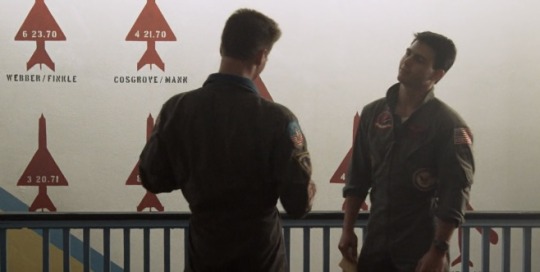

Ice is so, so interesting to me. The first scene where we see him standing up he's in his flight suit but notice his frame. He has that dorito shape that made hollywood go mad over Chris Evans. Broad shoulders and itty bitty waist
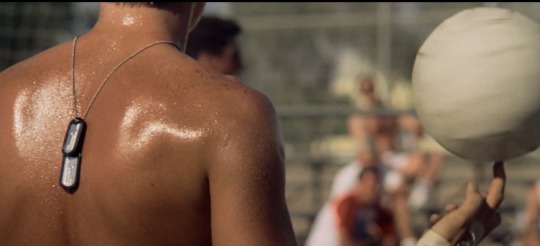
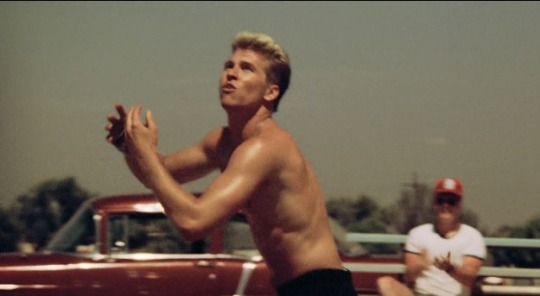
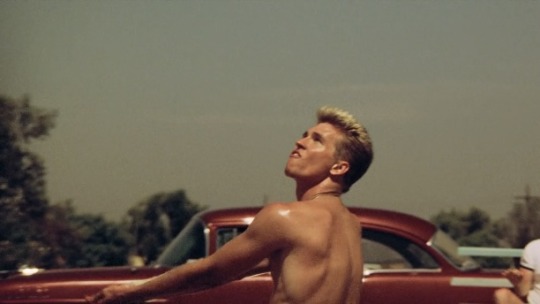
The beach scene, of course. Ice is probably the leanest of the cast (bar Goose, but again, i have REASONS). He's got pretty reasonable shoulders to give him the broad, inverted triangle shape. However we see when his scapular is exerted/fully rotated forward, we see more tendons and muscles (below, left). Also, in the photo above, look at those lats. Those are wings.


There's a little bit of tricep definition but Mav definitely rules the court on triceps. What we see in the pictures above though, is a back with really lean muscle. This tells us a lot about him.
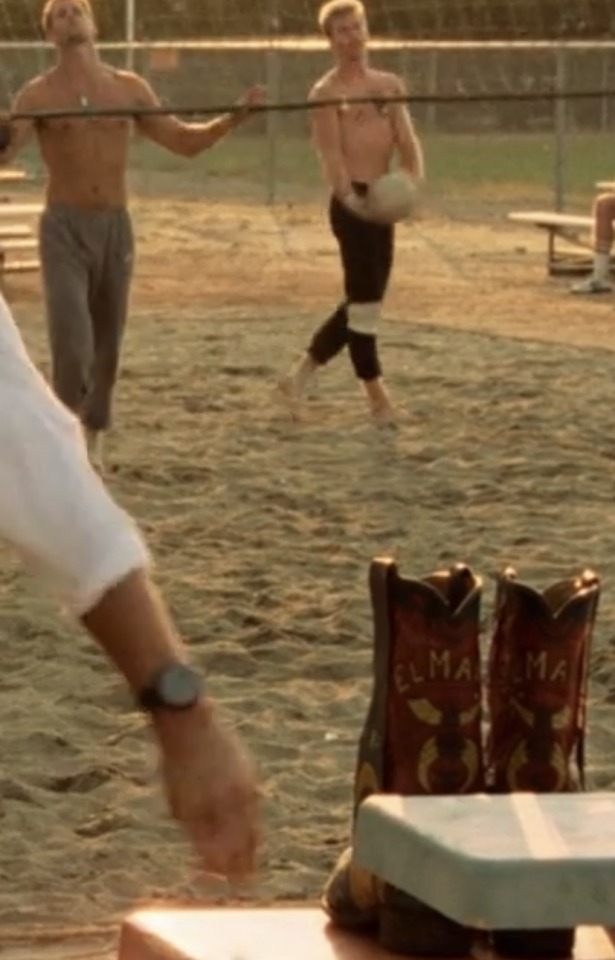

Another full body shot which highlights a few things. 1. I'm pretty sure that's a knee wrap, again, interesting in terms of injuries. 2. he also has an ankle wrap. 3. Look at the way he moves, poised, elegant. This is interesting again, it tells us a LOT. (Which i will explain in a minute)

Ice you are probably one of the two characters in Top Gun who pay attention to chest day at the gym. Very broad chest and upper body but not super defined abs, unlike Slider.
Ice has a very interesting body composition, he's lean but not under muscles. This leads me to think that he isn't a gym junkie. He's strong, for sure, and can certainly do all the compound lifts with some decent weight. But I don't think he's a bodybuilder or powerlifter like Slider and Mav. To be honest, I think the headcanon that Ice is a swimmer is incredibly accurate. He's lean, he's got lean muscling and the shoulders and lats to show for it. Also with a potential knee/ankle injury, running is very high impact and like Slider, Ice is tall. Tall people wear out. So swimming is very good for someone like him.
Exercises:
Swims every single day he can. Will run if he has to when he's on an aircraft carrier but prefers not to.
Hits the compound lifts and not much more. Squats, bench, and deadlift.
The way he moves is very elegant, so imagine kick boxing or a martial arts as well.

also gotta include this photo bc i forgot it for mav lmao, thanks @mavernick for reminding me of this wild confrontation avoiding posture lmao.
174 notes
·
View notes
Text
Round One, Part One!

Inverted Confrontation by @boots-with-the-fur-club
Cardinal Rules by @m0ths-wanderings / @dluebirb
71 notes
·
View notes
Text

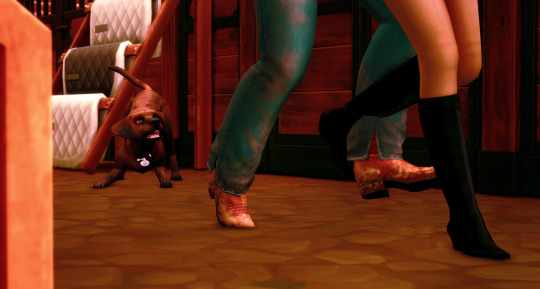
When confronted by an aggressor from behind, it is important to react instantly- without thought or mercy. Surprise is not on your side in these situations, so instead you'll just have to be faster.
𝗙𝗜𝗥𝗦𝗧: Swipe the leg. Throwing off their center of balance will be key.

𝗦𝗘𝗖𝗢𝗡𝗗: A sharp, quick strike with your elbow to the solar plexus.
This will create both distance between you and your attacker as well as provide an anchor for your defensive maneuver.
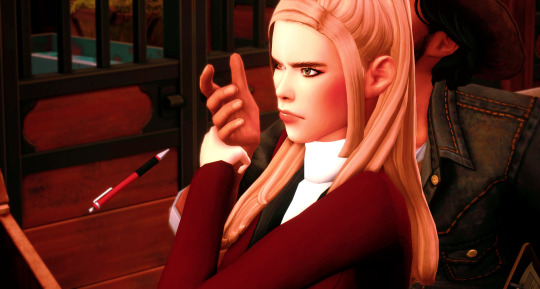
𝗧𝗛𝗜𝗥𝗗: Disarm.
Grab the wrist firmly and dig the point of your thumb into the main artery. In some cases this can help relieve nausea, but in those cases you probably aren't pressing hard enough.

𝗙𝗢𝗨𝗥𝗧𝗛: The Flip.
Using your elbow as an anchor, pull the captured wrist across your body in a quick downwards motion to invert your victim.

𝗙𝗜𝗙𝗧𝗛: Realize there's a small chance you might have overreacted.

It is at this point that the conversation can continue in several ways.
There's always the classic flirt and act dumb- but that had failed to earn her any ground that morning. She could make up something about taking self defense classes at her local community center-

And if nothing else worked there was always old reliable:
Knocked out cold and stuffed in the nearest grain bin- hoping no one notices til you're at least 50 miles clear of the crime scene.
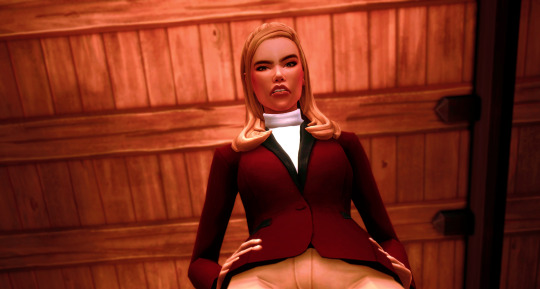
But seeing as they still needed a base of operations for the current mission, and they probably couldn't get their deposit back on the rooms anyway, 008 opted that the last option, while her favorite- might not help the current situation.
"I'm sorry- can I help you with something?"
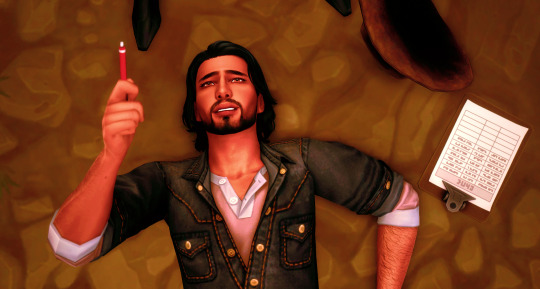
The man under her feet groaned and sheepishly offered her the pen she had classified as a weapon nearly fifteen seconds earlier.
"I uh- I need you to sign the form." The words croaked out of his bruised chest, any air successfully having been knocked from his body, leaving only gravel and dust.
Oh.

"To confirm that-"

"-to confirm that you brought my animals back in one piece, yes." he finished her sentence, the Agent grateful that he seemed to be taking the whole '𝘣𝘦𝘪𝘯𝘨 𝘢𝘴𝘴𝘢𝘶𝘭𝘵𝘦𝘥 𝘣𝘺 𝘢 𝘱𝘳𝘰𝘧𝘦𝘴𝘴𝘪𝘰𝘯𝘢𝘭 𝘢𝘴𝘴𝘢𝘴𝘴𝘪𝘯' situation rather well.


"And by the way- I don't squawk. I project."

"I'll make sure to keep that in mind."
38 notes
·
View notes
Note

Donnie and Beatrice are here to wish you luck for the story competition! (Donnie is, perhaps, a bit nervous. For reasons related to Bea. She's awfully pink.)
Hyde stares in wide eyed glee.
“You’re another me with a…is that your baby? Is it-are they….did we make her?”
He holds his hands together in excitement, although ignoring the loud voice in his head asking to hold her since this version of him looks so nervous.
@tmntstorycomp
@bambiraptorx Thank you for the ask!!
@daboyau
45 notes
·
View notes
Text
Wait, Zhao Yunlan's gun is actually a...?!
(I've never claimed production meta for @guardianbingo before, but after the amount of time and research I put in on this, I feel like I've earned the "Zhao Yunlan's Gun or Whip" square, haha)
SO. GUYS.
Maybe this is something fandom as a whole figured out back in 2018, but I, who didn't hear of Guardian until 2020, did not realize until now and I need to share the knowledge because when I finally noticed, I made an unholy sound.
I've tracked down where Zhao Yunlan's gun came from -- or at least, what it most likely started as. Not the in-universe dark-energy-maybe-uses-bullets-maybe-doesn't-device-that's-best-not-thought-about-too-long, but rather the actual fake-steampunk-revolver-that-is-best-not-looked-at-too-long-because-it's-awful prop.
Y'know, this disaster:
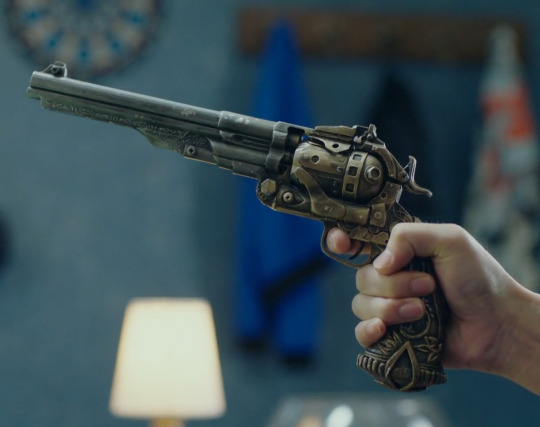
I was actually working on a different Guardian Bingo fill and needed to look something up for continuity, so I'd flipped through a couple of episodes at super high speed trying to find a scene. As luck would have it, one of my skips forward happened to land on the scene I screencapped above, when ZYL confronts Zhang Shi.
Normally we don't get this clear (or this stationary) a shot of the godawful gun prop. I'd assumed all along they had just taken a plastic gun, glued some extra bits and bobs on it to make it look fancy, and hit it with some dry brushing (fun fact: you can watch the paint flake throughout the series; check out the top of the barrel and the side of the cylinder in the above screenshot!) to make it look #steampunk like the abandoned aesthetic of 25% of the show (as I've said before, I have theories about what happened in preproduction, but that's another post). This sort of thing is exactly what I've done for cheap cosplay weapons or background props for film work that aren't going to be seen at HD detail range.
Anyway, since the detail showed up better here than in other shots, I paused the video to look at the random screws and hex bolts (why??) they'd glued on it, since I recalled that I had the aforementioned gun/whip bingo square to fill.
That's when I noticed a detail that had eluded me before: An inverted V shape at the bottom of the grip.

Only looking more closely, that's not an inverted V. It's a symbol that I've seen a whole series of variations of over the past 15+ years... every time there's a new installment of the Assassin's Creed video game series:

So I started hunting. The principal weapons in each game turned up no matches, but eventually I found a gun that looks almost exactly like ZYL's:
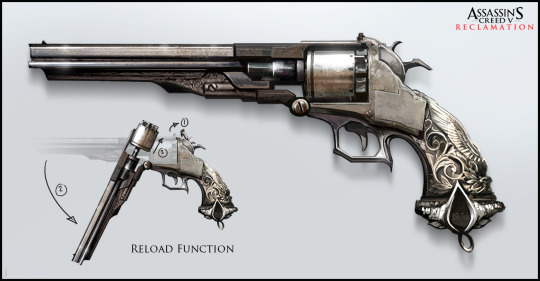
It's not a perfect replica, but the details are certainly all there: The stylized logo; the leaves and swirls on the grip; the feathers up the back; even the Victorian scrollwork beneath the barrel.
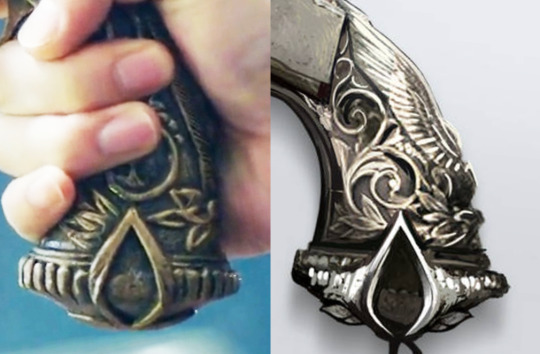
Now, what's really interesting is that this gun isn't actually from the AC game series. It's part of an elaborate fan project by artist David Paget that started as a class assignment back in 2014. Even though it gathered a bit of steam in the AC fandom and generated a couple of forum role-play groups, OCs and the like, nothing about this artwork was ever connected to a real Assassin's Creed title. So why would there be a physical version of a gun that was only someone's fanart?
This is where the smoking gun (*rimshot*) goes missing, because I can't prove any of this, and it's been long enough that digging through the archives of the internet to find answers is going to take way more time than I can afford to spend on a project I'm not getting paid for. But there are two likely possibilities:
Scenario A: Some employee in a toy factory somewhere in China got told, "This Assassin's Creed franchise is really big, so we need to be producing replicas from those games to sell. Work up some designs." So the employee Googles "assassin's creed gun," finds David Paget's very professional-looking art, and whips up a replica to mass-injection-mold without realizing it's not actually from a game. Later, someone on the cash-strapped Guardian production team needs a gun to mod, and finds a cheap toy revolver on clearance after several years of sitting in storage because there was little demand for a replica of a gun that was never in a game. They buy several, glue hex bolts on the cylinder for reasons unknown, and poof! Instant pseudo-steampunk!
Scenario B: Other fans were involved in the design. Someone did build a 3D model of David Paget's design that's still available on Sketchfab (screenshot below), and it's not unreasonable to assume that other fans could have thought it looked cool and built 3D printable models. Later, someone on the cash-strapped Guardian production team needs a gun to mod, and acquires the 3D print file of one of those models from the interwebs. They mod the file a bit, print some, glue hex bolts on the cylinder for reasons unknown, and poof! Instant pseudo-steampunk!

Personally, I find Scenario A far more likely than Scenario B, for two reasons: First, the hero prop looks more injection molded than 3D printed, especially given the technical state of 3D printing back in 2017-8. And second... Budget-challenged dramas do have a history of picking up bulk video game replicas and using them as cheap props. I made a post back in 2019 about the WoW Horde shields we spotted in a different drama...
Anyway, no firm answers about the source of the hero prop -- the world may never know! -- but we have now confirmed that in some alternate universe (possibly one of the first eighty?), Zhao Yunlan and/or Zhao Xinci is an Assassin.
Wait, wait, wait... *recalls mechanics of how the whole Assassin's Creed frame story is supposed to work* Uh... so... who wants to write a genetic memory explanation for the whole Kunlun -> [lots of lifetimes] -> Zhao Yunlan thing?
.
(I did actually check the catalogue of a friend of mine who makes replicas of props from various media franchises to see if he'd done a commission of the David Paget design, since a surprising number of his custom pieces actually do end up on film and television, but while he has a gorgeous replica of a revolver that actually appears in an AC game, it appears he has not done the Zhao Yunlan gun. I didn't really think it likely, since he's in the U.S., but you never know.)
#guardian#zhen hun#c-drama#guardian bingo#assassin's creed#tv props#it's always fun when my various hats end up stacked on top of one another
106 notes
·
View notes
Text
Pentacle vs pentagram vs inverted pentagram

Yes, all of these things are different and people often get confused on which is what and what they all mean. It is important to know which each one means if you are going to be practicing witchcraft or if you are going to wear or use these sigils and symbols. So lets get into it!

Pentagram-
The Pentagram is truly a sign of spiritual protection and ethereal global wisdom. It is also a symbol of the mind's control over the elements. When confronted with this emblem, evil spirits and other negative energies are rendered weak, while good spirits are drawn to it. Those who possess this sign have limitless options at their disposal.

Pentacle-
The Pentacle is a sign of good, pure, and white magic, as well as light and love. First, it represents the North, South, East, West, and Spirit. Second, it represents the Earth, Water, Air, Spirit, and the Divine. Third, it represents the god and goddess. If wrapped within a circle, it represents the totality and unification of all quadrants and elements, as well as our ultimate love for nature.

Inverted pentagram-
The upside-down pentagram is not just for Satanists. In fact, some Wiccan covens utilise the inverted pentagram to represent hierarchy. It's only that Satanists have taken it, and Wiccan covens seldom utilise it anymore.
Because of the association between the inverted pentagram with Satanism, Wiccans are more likely to use the Pentacle. It is more accessible and less prone to miscommunication.

20 notes
·
View notes
Text
The basement scenes in Beyond Evil
Some quotes are from the Beyond Evil scriptbook translated by @/yeoyuo on Twitter. (link to the scriptbook in the comment section)
The setting in Beyond Evil is always both significant and relevant: the reed field, Lee Dong Shik’s basement, Jae Yi’s butcher shop, the archives room, the Japanese restaurant, etc. These different places are highly symbolic — some more than others — and are essential to understand everything that is at stakes.
With this post, I want to give you my analysis of Lee Dong Shik’s basement.
The basement scenes are key moments of the drama for they mark crucial shifts, both in HJW and LDS’ relationship and in the plot itself.
The native title of Beyond Evil translates to Monster in Korean (괴물). The very definition of ‘monster’ is quite complex and even its etymology hints at the many roles monsters can play in our society (and in History more generally).
'Monster' probably derives from the Latin, monstrare, meaning 'to demonstrate', and monere, 'to warn'. Monsters, in essence, are demonstrative. They reveal, portend, show and make evident, often uncomfortably so. (source in comments) This last sentence encapsulates perfectly how Lee Dong Shik is seen by others; Han Joo Won acts as a reminder of such perception when he first arrives in Manyang and is convinced that LDS is the killer they’re looking for. Indeed, Lee Dong Shik is presented as someone demonstrative, whose agonising pain and temper earned him the nickname ‘nut job’ and the stares and distrust of most people in Manyang.
Lee Dong Shik is said to be a monster because he was the prime suspect of a murder he did not commit. Because he became a person so visibly drenched in his own pain that it became difficult to look him in the eye. He then depicts himself as a monster — by interfering in Min Jung’s case — to make sure HJW will play his game and take the bait, because he desperately needs HJW to “bite him”. Because he needs his help to catch Jin Mook and to find the missing bodies. Because if everyone keeps being blinded by LDS’ seemingly craziness, then Han Joo Won needs to be the one to see beyond. He needs to see the bigger picture.
The basement scenes play a huge part in making HJW see the bigger picture because so many elements of truth are revealed in LDS’ basement which makes me think… what if LDS’ basement was a means to rewrite Plato’s cave but in a more paradoxical way? Let me explain.
The basement is a place of confrontation and its dimly lit interior makes it resemble a cave, somewhere underground with no real light. HJW and LDS discuss and make hypotheses in this place, so often that LDS even jokingly suggests that HJW should pay rent at this point since he’s always in LDS’ basement.
What makes it a paradoxical rewriting of Plato’s cave is the fact that the truth is, in fact, found in LDS’ basement, on multiple occasions. However, in Plato’s cave, the cave is the place the philosopher needs to escape from to confront the real light, the sun’s light — i.e the truth — to eventually access the world of Ideas.
In Plato’s myth, the cave is a place in which chained prisoners stare at inverted shadows projected by the fire burning inside the cave and they take these shadows for reality. The fire in the cave represents the notion of culture which is to say, constructed beliefs (this is overly simplified but it’s just to give you an understanding). The people in Manyang are like those prisoners in the cave who are convinced that those shadows are what the real world looks like: they are convinced Lee Dong Shik is the cause of Manyang’s tragedy and doom despite the fact that many cases that took place in Manyang were dropped. The Manyang people believe in the evidence that is the guitar pick as fervently as the prisoners believe the shadows are the only reality that exists. Despite it not being enough to indict Lee Dong Shik, it still made him look like the killer for twenty-one years, to them at least.
Just like the philosopher who decided to climb up and face the burning sun to get to the Truth, Lee Dong Shik is the one who sacrificed himself and ruined his life so that the truth could be established.
To come back to what makes this rewriting paradoxical, here are some truths that were discovered in LDS’ basement:
The posters of the missing people + the files of both Yu Yeon’s and Ju Seon’s cases (before LDS put them back into the archives room) → These enable LDS to carry out his own investigation.
Min Jung’s fingers → LDS brings them to his basement before figuring out what to do with them.
Lee Geum Hwa → LDS figures out the name of the victim of HJW’s sting operation during one of his confrontations with him which took place in his basement.
Yu Yeon’s body → LDS finds the body of his sister inside a wall in his basement.
Jung Je’s memories → Again, Jung Je’s memories come back to him during a heated conversation with LDS in his basement.
However, LDS has to go up into the light, he has to leave the basement and his house to make the truth known. It is within hell that the truth emerges, but it is under the sun’s light that the truth needs to be revealed.
Thus it’s interesting to note that the big reveal — i.e the rain scene in ep 15 when HJW makes LDS listen to his audio recording — doesn’t take place in LDS’ basement but in his yard (outside and not underground). This emphasises the idea that, just like the bodies in Manyang, the truth needs to be dug out.
Just like Lee Dong Shik and the philosopher before him, HJW became the one willing to sacrifice himself so that everyone could know who the real killer was: “I’ll be a monster, take Han Ki Hwan with me, and dive into hell when he’s reached the peak.”.
#this sounded better in my head but I'm tired of rewriting it ><#I'm aware I oversimplified Plato's cave but I hope I got my point across#beyond evil#jtbc beyond evil#lee dongsik#han juwon#*enjoy my nonsense#*beyond evil analysis#my post won't show up in the tags because of the links so I'll add them in the comments
68 notes
·
View notes
Text
One Piece in Review, Part 2: Into the Grand Line (Ch. 42-100)
Welcome back to my One Piece reread review. In this part, we'll be covering the rest of the East Blue saga: Baratie [ch. 42-68], Arlong Park [ch. 69-95], and Loguetown [ch. 96-100]. Previous parts can be found here: Part 1 [1-41].

A number of major shifts happen in this segment of the story and it's for this reason that I think it's one of my favorite parts. At the conclusion of Syrup Village, our protagonists graduated from unnamed, utilitarian ships to their own caravel, the Going Merry, which allows them to be intentional about where they're heading. They also adopt a symbol, the skull and crossbones topped with Luffy's signature straw hat, which foretells how they'll eventually be dubbed the Straw Hat Pirates.
The creation of a flag and the addition of a ship with personality means that they now genuinely have something like a group identity, which is going to be tested quickly. And the increased size of the ship corresponds to the scope of the conflicts and world they're going to be involved in from here on out. As such, I think this segment of the story is a marked improvement along the dimensions of conflict, characterization, and scope. The main thrust of this story segment is getting the crew ready to enter the next phase of their journey - the Grand Line.
Villains/Conflicts:
Starting with the Baratie arc, the pattern established in the first three arcs - go to a new locale, confront a local villain while pursuing specific goals, recruit a new member - starts getting shaken up in unique ways or shifts away from that formula. For instance, after adding the ship's cook Sanji, the group's membership will not increase for about 80 chapters. In general, recruitment will become a lot more sparse throughout the remainder of the series, solidifying a central cast for the time being.
Also in Baratie we find a slightly more complex struggle at work. The main villain, Don Krieg, is in the unfortunate position of being sandwiched between two of the stronger early villains of One Piece, Captain Kuro and Arlong. He's something of a redundant character, repeating both Morgan and Kuro's respective traits of "belief in rank as strength" and "utilizing deception and underhanded tactics to advance his goals." He does have some good foil aspects, inverting Zoro's willingness to recognize a loss as such and Sanji's fundamental gratitude for what others have done for him. But what Krieg really does is give us 1) a rival in pursuit of the One Piece, and 2) an insight into the terrors of the Grand Line, explaining that he lost nearly his entire massive crew and fifty ships within one week there. It's a good way of setting the stakes in anticipation of finally making the voyage into this now repeatedly-teased part of the world.
In the prelude to the typical showdown between Luffy and Krieg, the figure of Dracule Mihawk comes in to basically disrupt the whole formula and tell everyone that these little backwater spats in the East Blue are not going to last, and we're not even *close* to the ceiling of how far things can escalate. Mihawk, while an antagonist, also isn't quite a villain: he basically shows up to fuck with the Krieg pirates like Bugs Bunny tormenting the opera singer, and only gets into a conflict with the Straw Hats when Zoro does something extremely, extremely dumb prideful. This is also kind of an upset, since it sees Zoro making a stab (ha) at his dream at a surprisingly early point. But the gulf between where the crew is at now, and where they need to end up, ends up being demonstrably enormous.


Though Krieg is a middling villain, the combined threat of him and Mihawk gives the Baratie arc its central thesis: willpower as its own kind of might. Luffy's battle against Krieg demonstrates how far willpower can take you, while Zoro's fight with Mihawk demonstrates that it's not sufficient without the force to substantively back it up. It also contrasts Zoro quite directly with Krieg, in that the latter persistently refuses to recognize when he's lost, while the former accepts defeat and (when given the opportunity to do so) learns from it, a lesson that will be necessary for taking the Grand Line seriously.
The titular antagonist of the next arc, Arlong, on the other hand, is an all-time great One Piece villain both for his place in the story now, and the long-term implications of his character as the story unfolds. The central conflicts of Arlong Park are about money, trust, and race. That last is probably the least substantively interesting right now, but becomes really fascinating later on. Arlong presents himself and his crew as "the master race," but in reality they come from a population that is socially subjected. But at this juncture of the story, we have a straightforward story about tributary exploitation. The sheer brutality of how Arlong treats the local humans he's extorting is unrivaled by anything prior to this, leaving lasting physical and psychological scars on the people. Since Arlong and his crew are explicitly presented as being products of the Grand Line, it really adds to the menace of that place.
Structurally, Arlong Park is also one of the most interesting of the early One Piece arcs, essentially split into two halves. The first is figuring out what's going on with Nami, why she's acting hostile to the others and why she's seemingly allied herself with Arlong, and reuniting the crew after a separation. This segment finds the group wheeling and dealing and clawing their way out of trouble, narrowly evading destruction by Arlong, as Nami in turn tries to push them away protectively while still preserving her plan and goals. After Nami's backstory is revealed, the story shifts into a more intense, battle-packed segment, with each Straw Hat confronting their own opponent for the first time, except for Nami, who stands alongside her community in support. They all work as a unit to overcome their opponents, learning more about how they interact and rely on each other. It has some of the genuinely most exciting and emotionally impactful storytelling in shonen manga that I've ever read.
The final arc of the East Blue saga, Loguetown, is one of many transitional arcs in the series (along with later arcs like Jaya, Long Ring Long Land, Amazon Lily, Zou, and the two "Post-" epilogue arcs). While these transitional arcs usually have their own conflicts, they are largely playing setup for upcoming ones. Loguetown is no exception, but it's the briefest of the bunch. A few key points:
Luffy gets his first bounty, 30 million beri. This is a big deal - while a lot of One Piece fans treat bounties like they represent power levels, they actually represent a social relationship between a pirate (or just an enemy of the government in general) and the World Government. With Luffy's bounty exceeding all of those he defeated so far in the East Blue, it illustrates that he's considered a substantive, if not huge, threat, and a sociopolitical indicator that he is ready for the Grand Line.
We get to see the place where the Pirate King died, but not only that, where he inaugurated a new historical epoch. This ties in heavily to another constant theme of One Piece, the idea of an inherited will: Luffy is nearly executed, and behaves in the exact same way that Gold Roger did when he was about to be executed. Visiting this place right before entering the next part of the sea suggests that Luffy is kind of picking up the spirit of Roger and starting his own legend from here on out.
We get the introduction of Captain Smoker, who is the first Marine in the series that isn't either a total bastard or a total incompetent, but remains an antagonistic force to the Straw Hats. This is used to plant the seed of different ideologies and conflict within the Marines as an institution. Smoker will be in pursuit of the Straw Hats throughout the next saga.
We get essentially the first taste of the Grand Line and what it's like: lots of Devil Fruit powers, new and strange technology, strong marine and pirate presence, major challenges, and the hint of deeper intrigue with the arrival of Dragon, who rescues Luffy from Smoker.
It's also in this series of arcs that I think we actually start to see Luffy and the crew meaningfully get challenged in terms of strength and ability. In previous situations, it was only contrivance or mistakes that got Luffy and the crew into trouble. But Krieg, while a blowhard, is definitely still a threat, whose unpredictability presents a serious challenge to Luffy (as does the environment in which they fight, as this is the first time we really get to see Luffy at risk from the tradeoff of the Devil Fruit). Arlong and his fishmen are the biggest threat that the whole crew has confronted so far, shown to be capable of upending entire villages. As fishmen, and former subordinates of a famous Grand Line pirate, they're also specifically denoted as products of the Grand Line, so confronting and successfully defeating them is an illustration of the fact that the Straw Hats are, at last, ready to enter that segment of the sea. And of course, Smoker and Mihawk outclass all of them easily for now, reminders that there is a long way to go.
Characterization:
Because of the increasing intensity and danger of the conflicts here, we get a lot more opportunities in this segment to see the Straw Hats develop and grow. In the first three arcs that I covered in the last post, the Straw Hats are visibly forming connections with each other; for instance, you can see it in the relaxed poses that Luffy and Usopp have around each other or the way the whole group drinks together. But it's only after the events of Baratie and especially Arlong Park that they begin to cohere as a group, rather than a bunch of individuals with their own self-interested goals that point in approximately the same direction. (I say "begin" because this is, as ever, a long game.)
Small or quiet character moments that were scattered throughout the previous three arcs start paying off, most notably for Nami in Arlong Park, but also for Luffy, Zoro, and Usopp. So, let's take them one by one (minus Zoro - I think I've exhausted what I have to say about him for the moment in the section on Mihawk above).
Usopp: Usopp doesn't get a lot to do in Baratie, mostly cowering on the sidelines with some minor character work, but in Arlong Park he basically has a miniature character arc which, in turn, sets up his long-term character arc. At its start, he's on some of his worst behavior, ditching Zoro potentially to die; while he has his heroic moments trying to protect Nojiko and Genzo from the Arlong crew's wrath, he repeatedly demonstrates having a somewhat blinkered view of the world, ranging from both the small (snide remarks about tattoos) to the big (his quickness to write Nami off and tendency to act rashly). It reveals a character that is struggling to understand his place in the world and the crew. At his lowest moment, when he's faked a death so that the Fishman Pirate he's fighting will leave him alone, he starts comparing himself to his crewmates, and their determination and willingness to put themselves on the line for each other.

At its conclusion, we finally get to see him stand on his own two feet (literally, since Zoro had to carry him during Syrup Village) in order to defeat a powerful opponent. We also really get to see him as a fighter, which is essentially a kind of guerilla-style, improvisational, hit-and-run approach, making him stand out within the crew's battle dynamics.
Luffy: I think Luffy sometimes gets regarded as a static or at least simplistic character, especially since what his Damage is doesn't get fully exposed until right before the timeskip. But what Luffy is going through in the first half of the series is the process of learning what it is to be a captain, and how to apply his philosophy of life to the process of leadership. This is illustrated by how he is contrasted against the various captains of other crews throughout the East Blue.
At the core of Luffy's character is an ideal of freedom. When Luffy inspires other people through his convictions and dedication to his dream of becoming Pirate King, there's certainly a typical shonen "power of friendship" vibe to it, fitting for the Romantic idealism (centered around willpower and emotions) that governs the logic of One Piece. But I think it's worth noting that Luffy usually removes obstacles in people's paths towards realizing the things they care about, rather than trying to impose his beliefs and choices onto them, or directly "liberate" them. One of the first things he did on his journey is liberate Coby, an enslaved child - not by first defeating his master, but by inspiring him to overcome the mental barriers that were preventing him from pursuing his goals. Free your mind and your ass will follow.
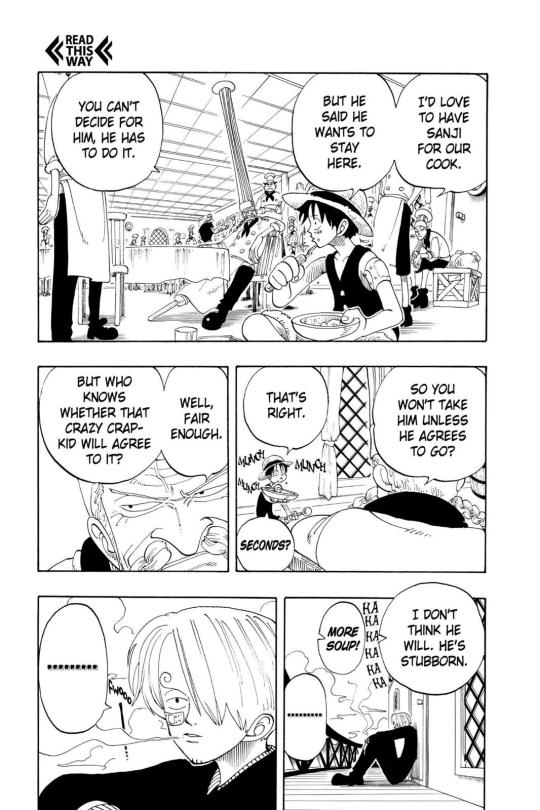
It's a recurrent element that Luffy basically does not give a shit about his friends' personal histories, and those histories are almost always presented through extended memory sequences (basically the character's internal thoughts) rather than literal explanations to other characters. Even in the rare instance where that isn't the case, like when Nojiko explains her sister Nami's personal history to Sanji, Usopp, and an unconscious Zoro, Luffy deliberately opts out. That's in part because, although *readers* need that information to give context and pathos to the characters, Luffy really doesn't. Luffy wants his friends to be able to live as they desire and that means moving forward, not back; the past, at a certain point, becomes another obstacle to pursuing one's dreams.
All four of the other main characters get inspired by the way Luffy acts and comports himself towards them in some way during this section of the story.
He disallows interference in Zoro's duel with Mihawk, but puts himself on the line after Zoro loses, demonstrating that he doesn't *just* care about his own dream but also Zoro's. This is where Zoro's loyalty to Luffy really cements, in his proclamation that he will never lose again and that Luffy is going to be the Pirate King.
He inspires Sanji to pursue his dreams by showing what it looks like to live life without regrets and to consistently put yourself on the line for your convictions, something Sanji is already familiar with but hesitant to fully embrace - and shows that sometimes causes seem more impossible than they actually are.
When Nami is at her lowest, darkest point, Luffy remains steadfast, even as she screams at him and tries to drive him away - and when, in a moment of peak vulnerability, she asks for his help and puts her trust in him out of desperation, he recognizes the pain she's been through and how hard it is for her to do so. In turn he gives her his hat to show that the relationship of trust is mutual: they can depend on each other, it is not weakness or a guaranteed loss of security.

But also, Luffy is learning from them, in a way. He's learning how to be their leader.
Nami: It's only in Arlong Park that we start to understand exactly what kind of strain Nami is under, but there have been hints leading up to it. I mean, look at this face:
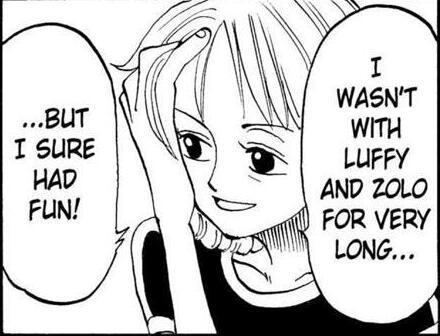
Those are the eyes of a tired woman.
Nami's whole life has been governed by money. As a child she didn't have enough of it, it was simultaneously a source of strain on her relationship with her sister and mother and an aspiration to make her dream of mapping the world possible. Then, upon the arrival of Arlong, money is the thing that tears their family apart: Bellemere doesn't have enough to pay tribute for herself and her daughters, so she makes a calculated maternal sacrifice to preserve their well-being. This was an unqualifiedly kind thing to do, but the tragic irony is that in doing so, Nami was opened up to abuse and enslavement by Arlong, who makes use of her natural talents at map-making and sets her a "task": if she can gather 100 million beri for him, she can free herself and her village.
Nami learns a variety of lessons from this course of events. Her money-lust is one - because money, in her mind, offers a guarantee of safety and security, that the things you really value won't be taken away from you. But the others are: relying on people you love will only get them killed, and if you just persist, if you just maintain the will to keep going and survive, eventually you will be free. The combination of these lessons lead her to repeatedly reject the Straw Hats from helping her or letting them into her burden. Nami believes in her own, constant self-sacrifice. While the substantive conflict of Arlong Park is about defeating the evil pirate lording over innocent villagers, the thematic and structural conflict is for Nami to learn that she doesn't have to hold onto these beliefs.
There are some complaints that circulate about how Nami doesn't take an active role in the final fight. Given Oda's inconsistent habit of sidelining female characters from the action (and it is inconsistent), I understand the concern. But I actually really like this choice in this case. Because Nami has been fighting. For eight years she has scraped her way towards freedom, getting shot and risking imprisonment or death and serving someone who could and would crush her sister's skull on a whim if he wanted to. She banked everything on a plan that gave her a semblance of control, that wouldn't require her to ask for help because doing so would just get people she cares about killed. And when it turns out that the plan can be disrupted by corruption and half-truths, she breaks. Her footing has been pulled out from underneath her, so now she has to take a leap of faith, and put her trust in others.
At the end of it all, she has a scar from where Arlong's tattoo was on her. Arlong influenced her deeply, for good and ill, and it's impossible to let go of that history entirely. But in the process she forges a new tattoo: a pinwheel and a tangerine, symbols of her mother and her community leader/father figure, a representation of how she's forging a new path for herself.
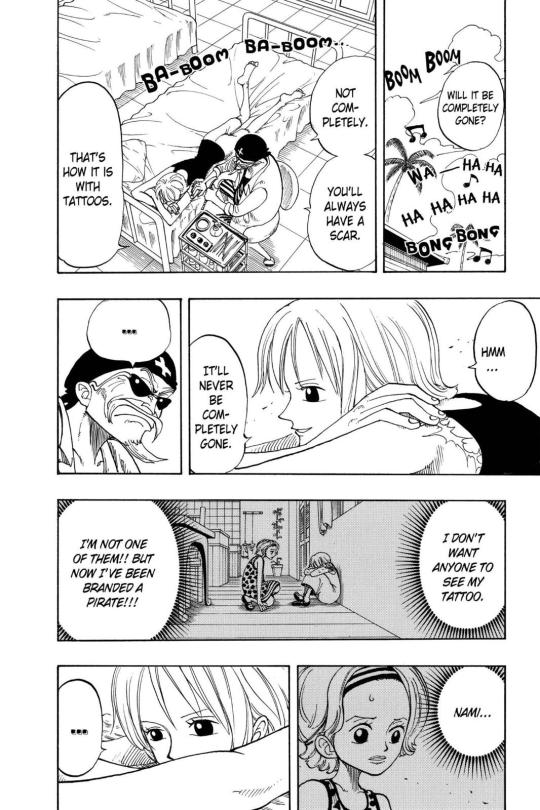

Sanji: Then there's the new introduction, the crew's cook. Sanji is a character that inspires a lot of mixed feelings in people. We will definitely get to the problems he presents down the line, but at this point in the story, I think Sanji is actually my second-favorite character in the crew after Nami. Like the rest of the crew, he has some notable vices, namely a tendency towards womanizing and "lovesickness" (which will get boiled down for jokes into 'perversion' as the series goes on, frustratingly) and a uniquely hot head even compared to Luffy and Nami. At the same time he's capable of tremendous compassion, effortlessly witty and suave (at least when he's not distracted), and demonstrates great tactical intelligence, like when he deduces the fish-man Kuroobi's weakness in the middle of a literally high-pressure scenario.

But as with many of the core cast's virtues and vices, they are rooted in personal histories. Sanji owes his life to his father figure Zeff, despite a contentious relationship. This theme of gratitude is central to Baratie: Sanji feeds a starving subordinate of Krieg's, and then Krieg himself, even despite knowing that it's a bad idea. Because Sanji knows intimately what it's like to be hungry. The subordinate, Gin, is tremendously grateful, while Krieg behaves like a total ingrate, making him a foil to both character. While Sanji's gratitude to Zeff is a defining feature of his character that we slowly get to see unpacked throughout the arc, his gratitude is shown to not be taking on a healthy expression, keeping him stuck in a small pond when he could be out there pursuing the All Blue (a mythical ocean with fish from all over the world). Gratitude doesn't mean dying for somebody, but living for them.
We also get a sense of the unfortunate gendered emotional repression that Sanji's experienced, and though I'm not totally sure the author would agree with my assessment, it's clear that Sanji's relationship with Zeff is based on passive-aggression, each trying to get the other to cooperate with what they *think* the other wants without being forthright. Zeff is deliberately trying to strain their relationship so that Sanji will pursue his dreams. Sanji feels such a mix of survivor's guilt and loyalty to Zeff, along with fear that his dream is itself foolish or doomed to failure, that he doesn't dare pursue his goals, and as such gets incensed by Zeff's backhanded attempts to push him out of the nest, taking it as a dismissal of his skills. At this juncture of the story, this is easy to read as a little like "real men don't cry or talk," but what's notable is that in the end of the Baratie arc, Sanji pushes past all that crap, just for a moment, in a genuine moment of emotional honesty. But this central emotional issue is still something that will stick with him, and comes up post-timeskip during the Whole Cake Island arc.
Part of the reason I'm spending a lot of time talking about Sanji is that Baratie, and then Arlong Park, are the first arcs where the whole shape of the conflict really centers around a dilemma that one of the main characters is facing; Zoro and Nami's introductory arcs are a little sparse and utilitarian, and Usopp's emotional conflict at Syrup Village was similar but less actively tied into the ongoing conflict. Sanji has lofty aspirations, but he's selfless and loaded with a lot of complicated emotions that hold him back from pursuing them. So seeing Zoro and Luffy put themselves on the line both for his home, AND for their own selfish aspirations, is a big deal.
So, that's the Straw Hats' arcs, for the most part. What I think is core is that each of them is in the process of recognizing things about themselves and learning to be part of a team, how they fit into a "crew."
Additionally, it's in these three arcs that we start seeing increased characterization for secondary and tertiary characters as well as secondary antagonists. There's not a lot to hold onto when you look back at a lot of the minor allies and enemies of previous arcs. Compare them to how much ongoing attention and characterization Patty, Gin, Zeff, Nojiko, Genzo, Hatchan, and Bellemere get, as well as how actively present in the action they are. This goes a long way towards making the world feel more alive and also gives the conflicts more weight: we care what happens to the Baratie or to Arlong Park, much more than unnamed villagers. Oda's character writing is definitely improving.
Unfortunately it's in this expanded focus that we see what is, in my view, a key weakness of One Piece: sometimes it outgrows characters in a way that leaves the story feeling a little uneven or bloated. Tashigi is the worst example of this, in my view, as she and Smoker get a huge amount of attention in Loguetown and Alabasta, only to sort of peter out as the Straw Hats grow past the need for Marines hunting them down. That might not remain the case forever - I suspect and hope that Smoker and Tashigi get a good role to play in the final saga - but it's hard to say.
Setting and Scope:
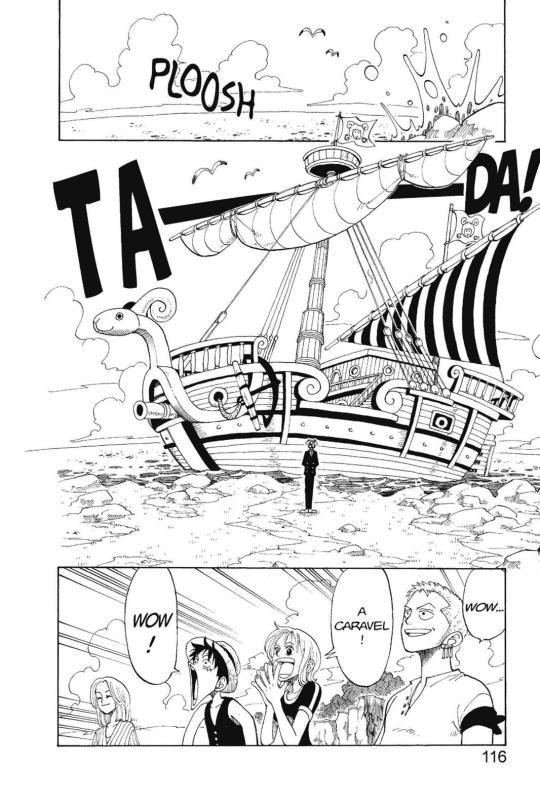
As I mentioned, the introduction of a ship marks a profound change in the way that One Piece works. By giving the crew a means of travel that is sturdier and more reliable than the impromptu vessels they've been relying on so far, they now have something like a "home" as well as a means to make more deliberate decisions about their next destinations.
The world starts to take on a greater shape in some major ways, and most of them are directed towards sparking further intrigue about the Grand Line and establishing it as a credibly wondrous but dangerous place. For example, the existence of non-human species such as fishmen is introduced during Arlong Park, a story element that will have huge ramifications down the line. As another example, we get some more information about Devil Fruits and how they work, most notably by introducing the concept of different Devil Fruit "types." These are later elaborated on as Zoan (animal transformations), Logia (elemental bodies), and Paramecia (kind of a grab bag). We also get Krieg's observation that the Grand Line is practically lousy with Devil Fruit users, which bears out once the Straw Hats encounter Smoker, a now empowered and redesigned Alvida, and Buggy all in the same spot just outside of the Grand Line.
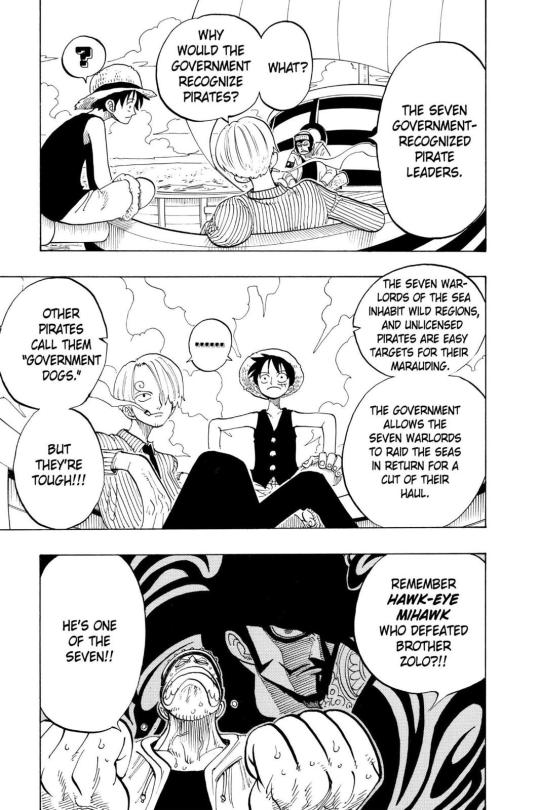
We also learn, by way of Mihawk, about the "Seven Warlords of the Sea" (who going forward I will alternately refer to as the Seven Warlords or the Shichibukai). Again, this shows how outclassed the Straw Hats are by the grander scope of their world, but what it also does is lay down the groundwork for one of the series' central conflicts, and I'd argue its most important: the corrupt and authoritarian World Government.
There's also, notably, a mention of "Three Powers" that control the Grand Line, and what the third one is will go unexplained until almost three hundred chapters later! I noted in the previous post that Oda, unlike someone like Akira Toriyama or Hirohiko Araki, doesn't write by the seat of his pants as much. This was maybe being charitable: instead what I'd say is that Oda rarely cheats. When Oda is backfilling or retroactively adding something, it rarely feels out of place, he usually leaves his mysteries and vague worldbuilding details open to enough interpretation that future explanations maintain their plausibility. This has a dual effect: it adds more fantastical details to the world, fitting as the crew gets closer to the super-fantastical Grand Line, but it also drives home how underprepared the crew is for some of the dangers they're going to encounter.
Another, smaller way that the world starts expanding in scope is the introduction of the "cover stories," many of which anime fans will miss out on. These are used not just to add fun details but to meaningfully flesh out later plot points. We get one story which documents the aftermath of Buggy's defeat which sets up his and Alvida's presence in Loguetown, and another about Coby's early days in the Marines that foreshadows important characters and points towards major growth for him.
The locations also take a step up from the somewhat dull environs of Shells Town and Syrup Village (I'm kind of an Orange Town defender now). The Baratie, for instance, is a delightfully charming setting that is fun to experience both when it's working as normal and when it turns into a combat zone. Arlong Park has a distinct geography and unique setting details like paddy fields, pools, and a Sea King that really make it feel dynamic and lived-in in a way that Syrup Village simply doesn't. Also, I believe it's the first time that Oda starts doing little maps as the characters plan out their next moves, which really helps ground the action and give an idea of how the setting works.
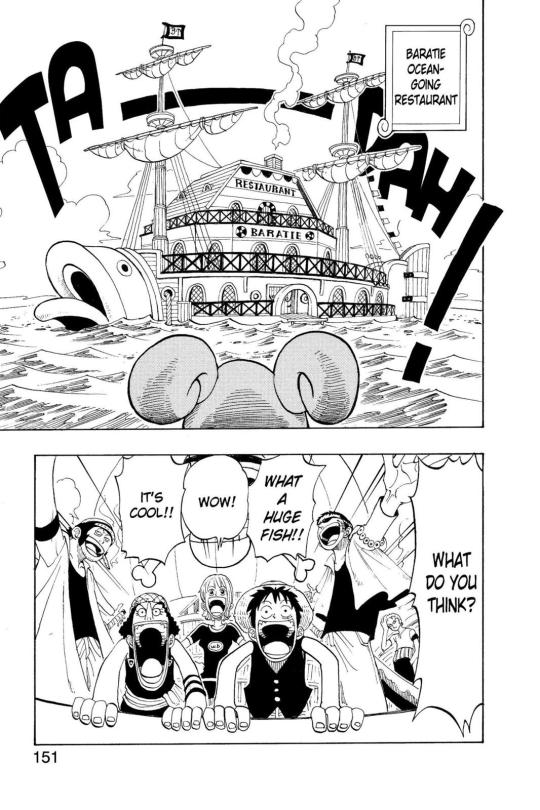
So, overall, this is actually one of my favorite segments of the early story. I think it clears away some of the growing pains of the early chapters, and shows that other aspects weren't in fact growing pains at all. It also introduces just an absolute mountain of motifs, characterization points, and setting details. This second half of East Blue is an excellent demonstration of the two things that Oda frequently excels at: an epic adventure full of fantastical things and places, and slow-burn character development for an ensemble cast. Additionally, the Romantic themes have started to lock into place: the ability to reshape the world through strength of will and commitment to one's convictions. Finally, I think Oda's artwork is steadily improving, though his extremities still need work.

I really like the take that these first 100 chapters form a sort of "prologue" for the series as a whole, since Chapter 100 is called "The Legend Begins," has a very explicit thesis statement, and ends with the crew reaffirming their individual dreams as a collective ritual before they enter the Grand Line.
In terms of the evaluation of each section: Baratie is a solid arc with a couple of things I could nitpick, but it's really carried by how different it feels from what's come before and the strength of Sanji's character arc within it. Arlong Park is one of the most emotionally moving in the whole series, and unquestionably has the best action of the East Blue. Finally, Loguetown is a thrilling cap-off to the first "part" as the series transitions into the next phase of the story: the Baroque Works Conspiracy.
Whew. This was a doozy to write, and to some extent it's possible I would have been better served dividing these arcs up to focus on them each in more detail...but here we are!
33 notes
·
View notes